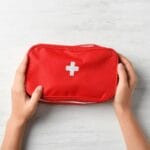If you’ve been in a hospital recently, you may have noticed a lot of stainless steel. Medical instruments, trays, railings, and wastebaskets, as well as tables and sinks in medical environments tend to be made of stainless steel. The benefits of stainless steel surfaces in hospitals derive from the nature of the metal itself.
Stainless Steel Is Non-Porous and Easy To Clean
Stainless steel surfaces are not porous. That means germs can’t sink into them and stay there. It makes them easy to clean, because simply wiping the surface with an appropriate sanitizing cleaner will take care of any germs on the surface, unless they are severely damaged with deep dents or pockmarks. Germs don’t linger on stainless steel.
Stainless Steel Resists Corrosion
Stainless steel is an alloy that contains nickel and chromium. Some varieties add molybdenum and nitrogen. The presence and proportion of the ingredients in the stainless steel alloy determine the types of environments the metal can endure. Lower alloyed versions handle humidity and water, while higher alloyed versions resist corrosion from acids, alkaline solutions, and chlorine. Type 304 stainless is often used in medical environments because it resists organic chemicals and dyes.
In businesses and buildings where harsh cleaning chemicals are used, stainless steel drains can withstand the effects as they carry away hot or hazardous liquids for containment. These drainage systems are used in hospitals, commercial kitchens, car washes, and chemical plants.
Stainless Steel Is Self-Healing
In the presence of oxygen, the chromium in stainless steel continuously renews a protective chromium-oxide film on its surface. If a stainless surface gets dinged or pockmarked, it will recoat itself with chromium oxide and retain its antimicrobial properties.
Stainless Steel Is Easy To Shape and Form
Stainless steel is easy to cut, roll, weld, bend, and form into a variety of shapes. Its components make it non-magnetic, and heat won’t make it harder. It can be formed into beds, railings, bedpans, chairs, sinks, and faucets easily.
There are many benefits to stainless steel surfaces. For hospitals, the primary advantages are that it is easy to clean and sanitize, and resists corrosion and rust.






